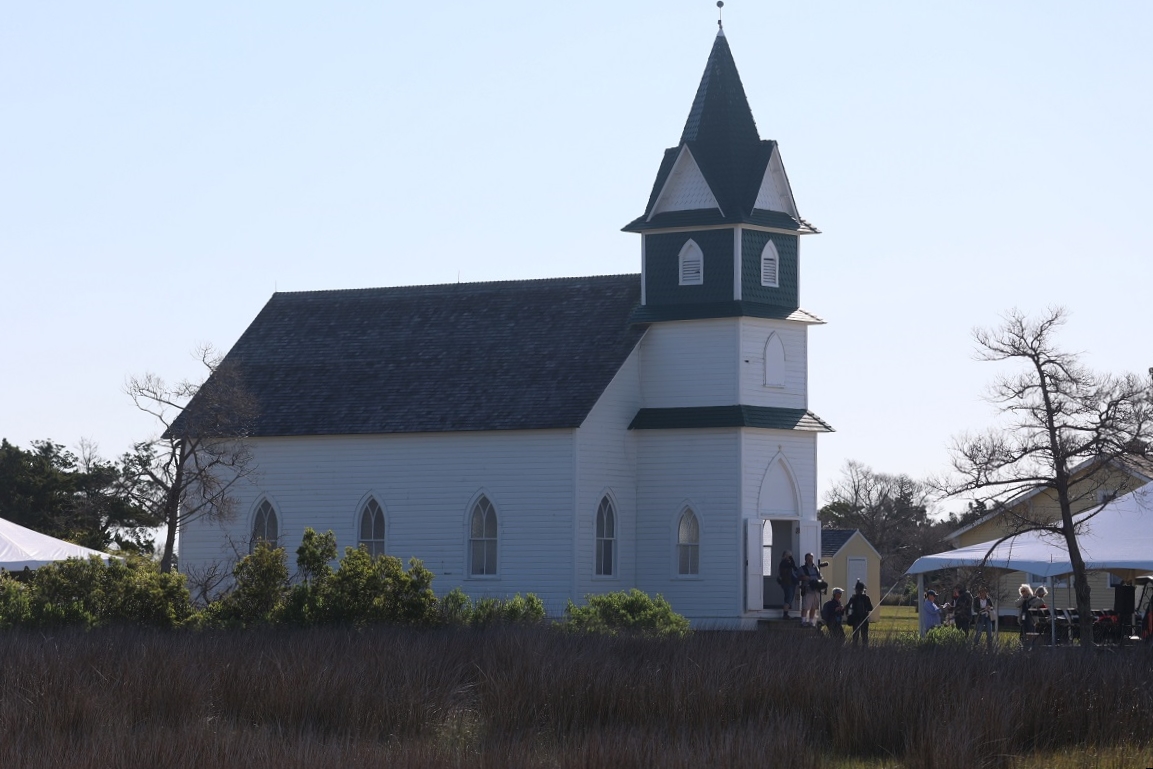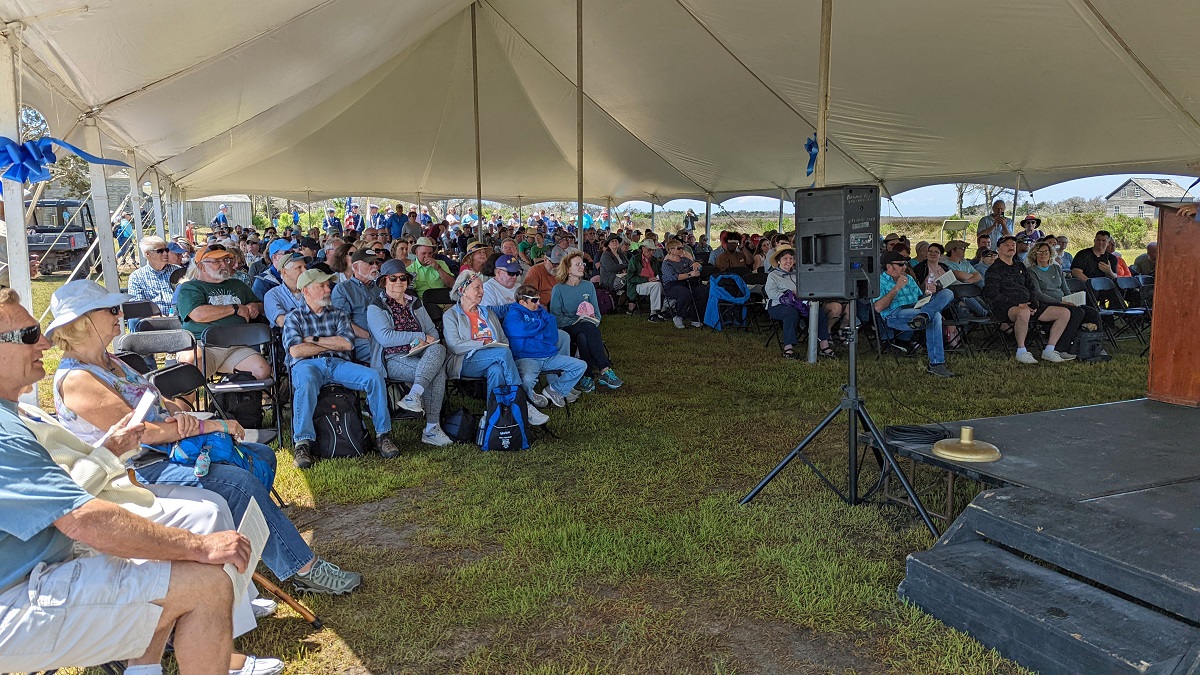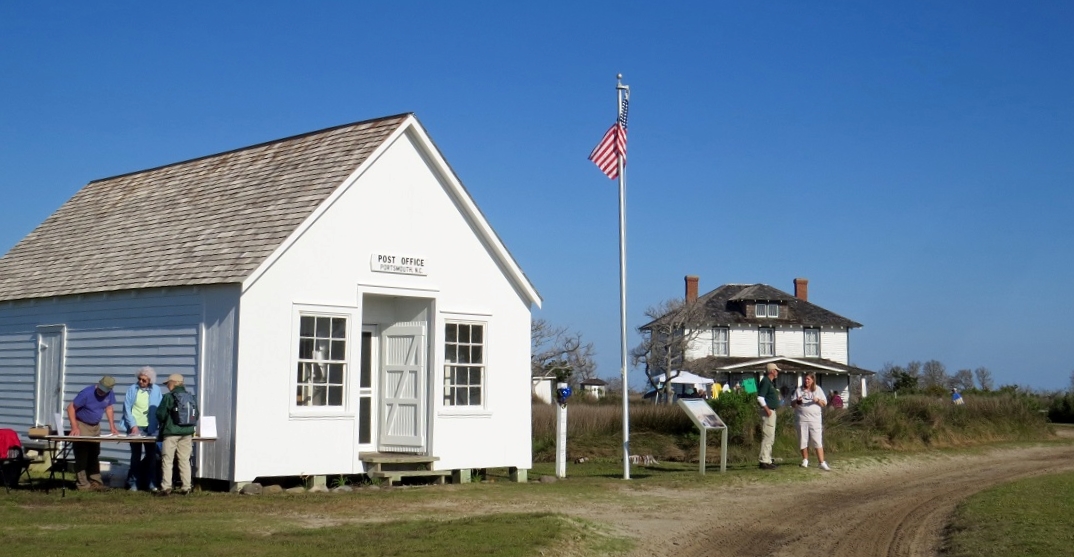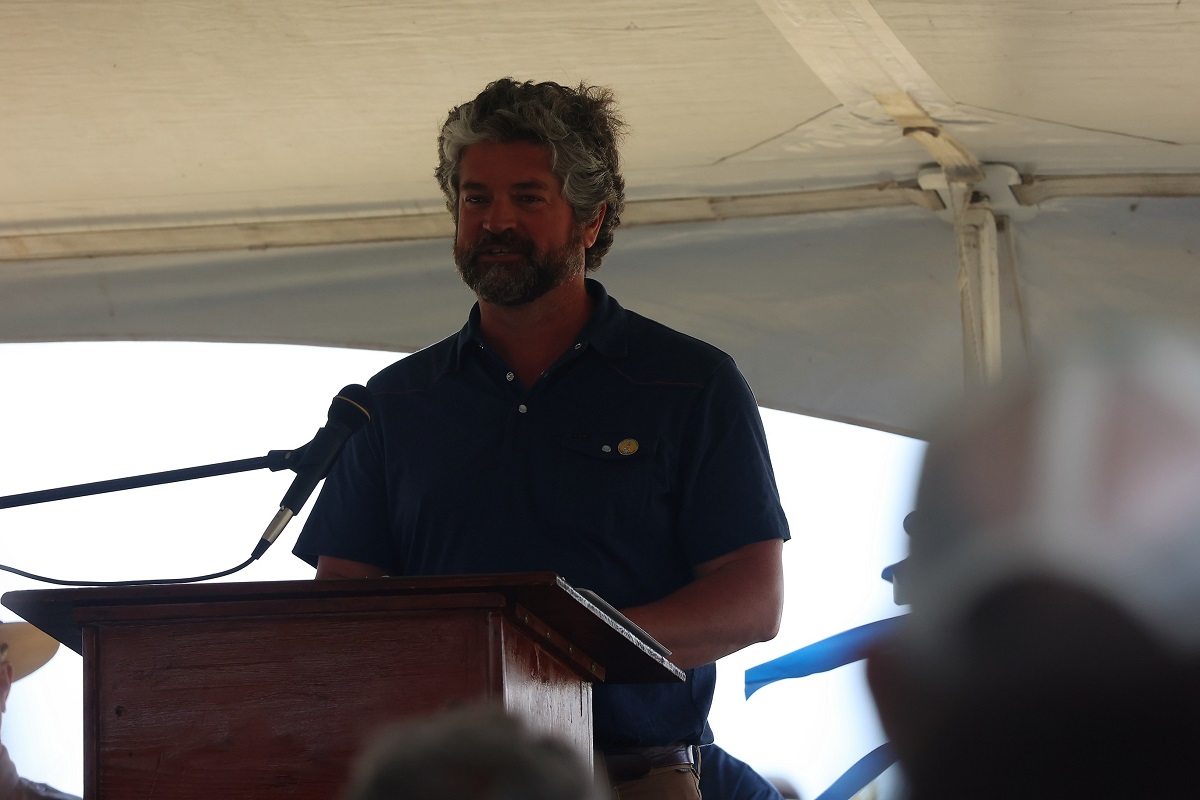
Special to Coastal Review
On a clear day, Portsmouth Island can be seen from Springer’s Point on neighboring Ocracoke Island.
Supporter Spotlight
From this side of Ocracoke Inlet, it appears to be nothing more than a mottled patch of marsh on the horizon, a mirage dancing across the sparkling sound.
These days getting to the island’s village is possible only by boat. The grassy Portsmouth Village Airstrip officially closed in 1996, eliminating air travel. In 2019 Hurricane Dorian cut new inlets through the long stretch of beach extending southwest from the village like a sandy comet’s tail, eliminating four-wheel-drive access from areas farther south.
Most people arrive from Ocracoke, ferried by captains Rudy and Donald Austin, who run Portsmouth Island Boat Tours. They follow in the footsteps of their late father, waterman Junius Austin.
On the 25-minute boat ride this day, the passengers, many of them descendants of the island’s families, watched the church’s steeple rise above the marsh as they crossed Ocracoke Inlet under a pristine sky. At the sight of it, they knew they were home.
Portsmouth’s last three inhabitants left the island in 1971 and it now only welcomes visitors.
Supporter Spotlight
But every two years, the island returns to life as hundreds gather in the historic village for the beloved Portsmouth Homecoming ceremony.
The event is jointly sponsored by the Friends of Portsmouth Island and the Cape Lookout National Seashore, has taken place every two years since the tradition formally began in 1992, informally before then.
But like many special occasions in 2020, it was canceled due to the COVID-19 pandemic, making it a painfully long four-year wait to celebrate the island’s rich heritage once again.
Given the hardships since its last occurrence in 2018, the return home was especially sentimental. The theme, “Portsmouth Rises,” was fitting for the island’s recovery after Hurricane Dorian brought devastation to the village in September 2019, flooding and damaging virtually every building and structure.
The Cape Lookout National Seashore staff, led by Superintendent Jeff West, along with the Friends of Portsmouth Island were undaunted in their efforts to restore the village. While some would have written off the village as irreparable, they devoted themselves to building repairs and groundskeeping, understanding the importance of place and that no appraisal could ever quantify the value of home.
The National Park Service, which manages the historic village, along with the many Friends of Portsmouth Island volunteers, welcomed around 400 guests April 23 for the long-awaited homecoming.

After walking down the long haulover dock, folks stepped onto the island and perhaps for a brief moment felt like they had gone back in time. They headed to the staging area, the Salter-Dixon House, which now serves as the visitor center.
At the nearby signup table, volunteers followed the tradition of handing out commemorative pins. The design features a beaming sun rising behind the church and reads “Homecoming 2020,” a reminder of how life as we know it was put on hold for the past two years.
A film crew made the trip across the water with their equipment and moved around the island throughout the day. The Tamassee Group, a nonprofit independent filmmaking group in collaboration with The Southern Documentary Fund, is producing a documentary for PBS North Carolina on the cultural and environmental history of North Carolina’s Outer Banks. They found the homecoming and the maintained village an ideal place to begin filming their project, which aims to capture the rich history of the Outer Banks before it is obscured due to rising sea levels and the rapid development of the area.
Generations of descendants with this shared history had the opportunity to meet up with old friends, to see firsthand how the village’s foliage and buildings fared over the past four years and to visit their family cemeteries nestled among the reeds. A few in attendance had lived or spent time in the village as children and were able to visit their family homes.
Frances Eubanks, descendant, author and photographer, and a founding member of The Friends of Portsmouth Island, has fond childhood memories in the village. Her grandparents were postmistress Annie Dixon and Theodore Salter. Their home, the Dixon-Salter House, is now the visitor center for Portsmouth Village.

Frances’ mother, Clara Salter Gaskins, as well as Annie and Theodore Salter, were born on Portsmouth Island. Clara was born in 1917, a year the sound froze over, causing the recording of her birth at the Carteret County Courthouse to be delayed. Clara grew up on Portsmouth, graduating from Ocracoke High School. After she was married, she returned to the island during summer vacations with her daughters to instill in them not only a love of her grandparents but also a love of Portsmouth.
Frances treasures a photo of herself around age 2, helping “Granddaddy” feed the chickens in the backyard; another, circa 1944, of her seated in a wooden, child-sized chair with a side view of the Dixon Salter house in the background; as well as the 1949 Cape Lookout National Seashore photograph in front of the church in which Frances appears with her mother (who was pregnant with Barbara Gaskins-Eugene at the time) along with other relatives and Portsmouth residents.
“I was really glad somebody had a chance to take those pictures,” she remarked, gazing toward the house. “Not everybody had a camera back then, so it’s special. They’re priceless.”
Former village caretaker Dave Frum was in attendance as well. While not an ancestor of Portsmouth, one could say Frum is the next best thing. For 28 years he looked after the village part-time, taking his skiff over from Ocracoke. He retired in 2016 and was pleased to have a reunion with West, his former boss, and his predecessor, acting superintendent Bob Vogel.
In attendance also were Kenneth Burke, renowned scholar on the history of Portsmouth village, who traveled from his home in Washington, D.C., and Chester Lynn of Ocracoke with long ties to Portsmouth and the man responsible for organizing the hanging of wreaths at Christmastime on the doors in the village.
A favorite stop for many during homecoming is the Henry Pigott house, a storybook cottage painted a charming yellow with green shutters and a cozy front porch. Henry Pigott was one of the last three people to live on Portsmouth Island and, as historian and descendant David Quinn put it in his remarks to the gathered crowd, “Henry Pigott’s heart became the beating heart of the island.”
After Henry’s death in 1971, daily life in the village could no longer be sustained and the two remaining residents, Elma Dixon and Marian Babb, left the island.
Henry inherited his house from his grandmother, Rose Ireland Abbot, who was the only formerly enslaved islander to remain in the village. As a midwife, she was an important member of the isolated community and safely delivered its children, while raising a large family of her own.
Of the remaining 20 buildings of a once-thriving village, 11 of them were open to the public.
The Portsmouth Island post office, a tidy white building that once also housed the general store, closed its doors in 1959 after 119 years of service. But on this day, it welcomed visitors who could have their post cards and envelopes processed with the Portsmouth Island Cancellation stamp by Melissa Garrish Sharber on assignment from Ocracoke’s post office and Hatteras Post Office Postmaster Vivian Barnett.
The schoolhouse embraced the return of children, their laughter carrying across the island. In its heyday around 1860, about 100 pupils attended school, but enrollment dwindled steadily over the years, leaving only one student when it was permanently closed in 1943.
And for one day, the long-silent sanctuary of the Portsmouth Methodist Church was once again filled with a harmony of voices for the traditional hymn singing that took place after a christening performed by Pastor Ivey Belch of Ocracoke’s Life Saving Church.
The Homecoming has a tradition of an hourlong formal ceremony beginning with a Presentation of Colors by the U.S. Coast Guard. Kathy McNeilly, president of the Friends of Portsmouth Island, welcomed the attendees. Author, educator and Portsmouth Island descendant Jim White served as the Emcee.
David Quinn, grandson of Dot Salter Willis, presented a brief history of the island and said in his opening remarks that “Home is where you go to find solace.” Quoting Lakota leader Crazy Horse, he added, “My home is where my people lie buried.”

Superintendent West provided an overview on the current state of the village and the many building repairs following Hurricane Dorian. He extended a heartfelt thank you to his staff and volunteers for their dedication to upkeeping the village, especially noting longtime caretakers and volunteers Ed and Renee Burgess for over 20 years of service in the village. This year will be their last.
Just as music was a vital part of village life in years past, it plays a key role at the homecoming celebrations. Folk singer Connie Mason sang her stirring composition, “Marian’s Song,” in honor of Marian Babb. Carol Scheppard, granddaughter of Sarah Lincoln and James Archie Newton, the lighthouse keeper at Cape Lookout during World War II, sang a cappella the “Mingulay Boat Song” for the crowd before performing it on bagpipes.
The Roll Call of Families concluded the ceremony as descendants proudly rose from their seats upon hearing their family names.
The day ended the way a community bonds best — over food. The homecoming’s traditional potluck lunch left no one hungry and brought together the celebration’s organizers, attendees, old timers and newcomers alike on their beloved island at the edge of the sea.







